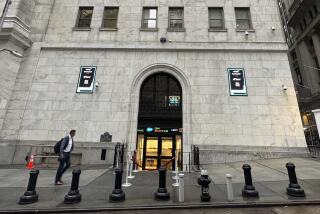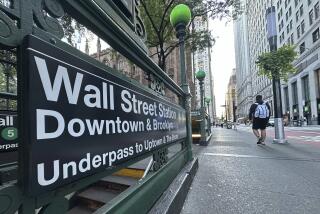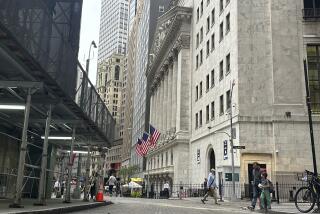Stocks coast to sixth weekly advance as rally continues
There is a moment in every bull market when investors worry more about missing gains than suffering losses.
The current rally appears to have reached that point.
The market coasted to its sixth straight weekly advance Friday, propelled by optimism over the Federal Reserve’s easy-money policies and a torrent of cash from small investors.
The Dow Jones industrial average jumped 85.48 points, or 0.5%, to 15,961.70, its 38th new high of the year. The blue-chip index rose 1.3% for the week.
The Standard & Poor’s 500 index gained 7.56 points, or 0.4%, to 1,798.18. The index notched a 1.6% weekly gain.
Investors are pouring into stocks on the belief that share prices will keep powering ahead in the final six weeks of this year.
Stocks were boosted by testimony Thursday from Federal Reserve Vice Chair Janet L. Yellen, President Obama’s nominee to head the central bank. Yellen indicated at her Senate confirmation hearing that she would maintain the Fed’s economic-stimulus efforts, which are widely credited with driving share prices higher.
Traders were thrilled when Yellen dismissed growing talk among some on Wall Street that the market is entering a fresh bubble.
“It’s Yellenomics, [the belief] that she is going to give [the market] all the money in the world,” said Bill King, chief market strategist at M. Ramsey King Securities in Burr Ridge, Ill.
The rally has intensified a debate on Wall Street about whether share prices are getting overheated.
Bulls say the market’s gain is justified because the economy is steadily improving, inflation is tame and corporate profits are rising.
Skeptics worry that the market has been swept up by its own momentum and that share prices are not justified by the underlying condition of the economy. For example, sales at big companies are expected to barely rise in the fourth quarter as cautious consumers rein in spending.
Revenue for companies in the S&P 500 is expected to rise a mere 1.5% in the fourth quarter compared with last year, said Howard Silverblatt, senior index analyst at S&P Dow Jones Indices.
“Companies are not making the sales,” Silverblatt said. “They’re squeezing the bottom line.”
Wal-Mart Stores Inc., for example, beat analyst third-quarter earnings estimates by 1 cent Thursday. But revenue was disappointing and the giant retailer warned that the crucial holiday selling season would be weak.
The advance in the market is being driven partly by individual investors, who are suddenly agog over stocks.
Enticed by the market’s blistering performance this year, retail investors have poured nearly $20 billion into domestic stock funds over the last month.
Their timing has intensified worries on Wall Street about the sustainability of the rally.
Small investors historically jump into stocks long after bull markets are underway, leaving themselves vulnerable to sharp losses when an eventual downturn hits. The current rally began in March 2009.
“They might catch a little part of that bull market when it jumps into irrational optimism,” said Jason Hsu, chief investment officer at Research Affiliates in Newport Beach. “But the likely outcome is they’ll ride that last-gasp bull market for a short while and experience an enormous loss in personal wealth when the bubble collapses.”
Small investors are not alone. Hedge fund managers and other professionals also are jumping into the market, experts say.
Many have underperformed the broad indexes and are scrambling to boost performance for fear of disappointing clients.
“When money’s coming in, the typical professional move is to invest it in order to keep up with the S&P,” said A.C. Moore, chief investment strategist for Dunvegan Associates Inc. in Santa Barbara. “Investors don’t tend to forgive you [for underperformance] when markets are up. People want to see you keeping up with the markets.”
For the time being, there’s little doubt about the power of the rally.
The S&P 500 is up 26% this year, just shy of its 26.4% gain in 2003.
The number of S&P stocks that have risen this year — 445 — is close to the recent record of 458, achieved in 2003, Silverblatt said.
Of those stocks, 79 have risen at least 50% and nine have more than doubled.
“People are afraid if they don’t jump in right now they’ll miss [the bull market] entirely,” Hsu said.
More to Read
Inside the business of entertainment
The Wide Shot brings you news, analysis and insights on everything from streaming wars to production — and what it all means for the future.
You may occasionally receive promotional content from the Los Angeles Times.










